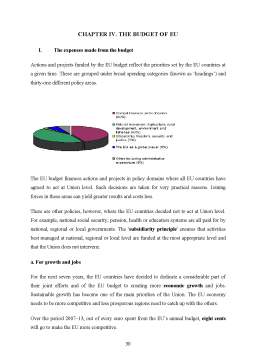Extras din curs
Introduction
More and more frequently you can hear people wondering what is all about with the economic integration and European Union, what these things mean and in what way they are going to influence their lives. In the past, prior to 1950, the term of economic integration was used to refer to almost any area of international economic relations. After 1950, the economists specializing in international trade adopted a new, more elaborate definition. More specifically, economic integration means the discriminatory removal of all trade impediments between al least two participating nations and with the establishment of certain elements of cooperation and coordination between them. There are different forms of economic integration and the European Union is one of them.
The idea of European unity goes back to the fourteenth century when Pierre Dubois proposed a European Confederation to be ruled by a European Council of wise, expert and faithful men. In 1693, William Penn, the English Quaker, wanted the creation of An Imperial Dyet, Parliament or State of Europe in his Essay “Towards the Present and Future Peace of Europe”. However after the First World War politicians began to give serious consideration to the concept of European unity. In 1923 Count Coundenhove Kalergi, the Austrian founder-leader of Pan-European Movement, called for the formation of a United States of Europe. On 5 September 1929, the French foreign minister, Aristide Briand, with the backing of his German counterpart, Gustav Stresemann, proposed the creation of a European Union within the framework of the League of Nations, and reiterated this later, when prime minister, by declaring that part of his manifesto was the building of a United States of Europe.
The main reason for the pursuit of European Unity was the achievement of lasting peace in Europe. However, economic reasons were also a contributing factor.
Despite the fact that there was no shortage of plans for creating a united Europe, nevertheless it was not until 1945 that action was prompted.
CHAPTER I. SHORT HYSTORY OF THE EUROPEAN UNION
The first concrete move for regional integration in Europe was made in 1947 with the establishment of Economic Commission for Europe (ECE). Also, in 1948 the Organization for European Economic Cooperation (OECC) was formed and was followed a year later by the Council of Europe. These marked the beginning of the splitting of Western Europe into two camps, with, on the one hand, the UK and some of the countries that later formed the European Free Trade Association (EFTA), and, on the other, Belgium, France, West Germany, Italy, Luxembourg and the Netherlands, usually referred to as the Original Six that subsequently established the European Economic Community (EEC).
The next step in the economic and political unification of Western Europe was taken in 1951, when the European Coal and Steel Community was created by the Six and marked the parting of ways in post-war Western Europe. In June 1955, at Messina, Italy, at the meeting of the foreign ministers of the Six was considered the memorandum proposed by Belgium, Netherlands and Luxembourg regarding the establishment of a general common market and specific measures in the fields of energy and transport. The governments of the Six established that a general common market and an atomic energy pool should appear. In the end, after three years of negotiations, the Six agreed that the drafting of two treaties, one to create a general common market and another to establish an atomic energy community, should begin. Treaties were subsequently signed in Rome on 25 March 1957. The EEC and Euratom came into being on 1 January 1958. Thus, in 1958 the Six belonged to three separate entities: the ECSC , EEC and Euratom. Later became convenient to consider the three entities as branches of the same whole, with EEC becoming the dominant partner. The whole structure was named European Communities, or European Community (EC), whose main constitutional base was the Treaty of Rome, creating the EEC. The need of institutional strengthening of EC become more clear by introduction of summit meetings which try to bring national political leaders more closely into the EC affaires. In 1974 these were formalized under the name of European Council. The 1969-1972 periods can be described as one of great activity.
Preview document
Conținut arhivă zip
- European Business Environement.doc



































































































